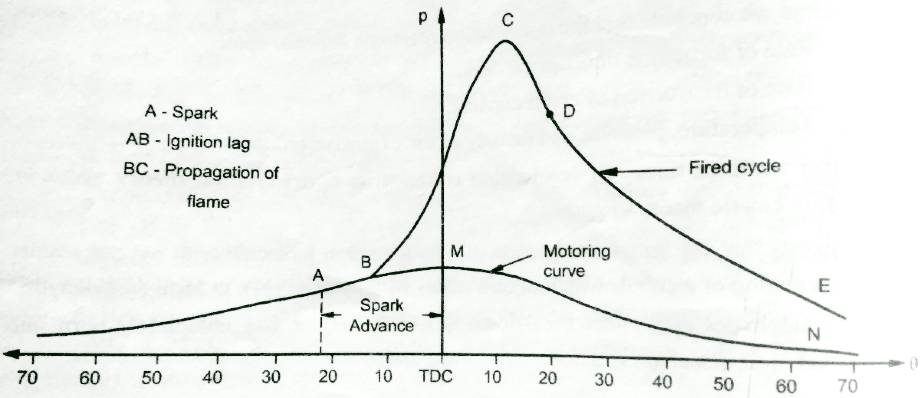In the previous article, we have discussed various stages of combustion in CI engine. In this article, we will discuss different stages of combustion in SI engine.
In SI engines or Spark Ignition engines, air and fuel mixture in a proportional ratio is supplied to the combustion chamber with the help of carburetor. This air-fuel mixture in the combustion chamber is ignited using a spark plug which provides a high-intensity spark. This spark initiates the combustion process in the combustion chamber.
The full combustion of the air-fuel mixture depends on the rate of heat transfer between the first flame and surrounding area of mixture, pressure, and temperature.
To understand the combustion phenomenon in SI engines, Recardo carried out an experiment using a quartz cylinder and high-speed photography. In the below figure, you can see the curve ABMN which is a motoring curve (When the engine is not firing) and the curve ABCD which is a combustion curve (When the engine is firing).

Table of Contents
Stages of combustion in SI engine:
On the basis of Recardo experiment, there are three stages of combustion in SI engine as given below:
- Preparation phase
- Flame propagation phase
- After burning
1. Preparation Phase
The preparation phase is also called a period of ignition lag. This is the first stage in the combustion stages in SI engines. According to the experiment, there is some time interval between the first spark given to the mixture (at point A) and the first flame appears out of the mixture. This time interval is known as ignition lag and it is represented on the above map as period AB. Due to this combustion, there is a clear rise in cylinder pressure.
This ignition lag represents the preflame reaction. According to the chain reaction theory of combustion, in preflame reactions chain carriers are produced.
During the AB period, the angle changed by the crank between points A and B is known as the ignition delay angle.
This first phase or preparation phase in stages of combustion in SI engines depends upon the different factors such as the temperature of fuel, pressure, molecular structure of fuel, density and air-fuel ratio in the combustion chamber.
See Also: Reasons behind knocking in CI engines
2. Flame Propagation Phase
When the first flame appears after the spark at point B, this flame travels surrounding and burns the fuel in different layers. This fuel burning rate and flame speed are noticeably low and there is a small but steady pressure rise in the combustion chamber.
This burning of air and fuel in the combustion chamber continues further and it causes a continuous rise in pressure and temperature. It releases heat energy in the combustion chamber which is transferred from burned to unburned charge. The speed of flame propagation is becoming very high in the range of 15 to 35 m/s.
Differentiating between the first and second phase i.e. Preparation phase and flame propagation phase is quite a difficult task. But you can distinguish between these two phases by observing ( P – θ ) diagram given above. The second phase i.e. flame propagation phase starts when the pressure in the combustion chamber starts rising at point B and the phase ends when the highest pressure is achieved in the cylinder at point C on ( P – θ ) diagram.
Curve BC on the diagram represents the rate of pressure rise. The rate of heat transfer to the cylinder walls is very low at the beginning of the flame propagation phase. This stage is one the most important stage in the stages of combustion in SI engine.
3. After Burning
We attained point C in the second stage of the combustion. But, it does not represent the completion of the combustion of the mixture. Because of the continuous burning of the remaining fuels in the cylinder and reassociation of dissociated gases in the combustion chamber.
During the expansion stroke, the combustion of air and fuel mixture continues after point C. This phase is called after burning. After burning represents the third stage of combustion in SI engine up to point D on ( P – θ ) diagram.
During after burning phase, flame velocity reduces to a certain level. This was the last phase of the stages of combustion in SI engine.
Conclusion:
In this article, we have discussed three various stages of combustion in SI engine such as Preparation phase, flame propagation phase and after burning using ( P – θ ) diagram given above. The diagram/map is drawn using the values from the Recardo experiment. If you have any queries regarding this article, feel free to ask it in the comment box.
what is Basic of Recardo EXp
Thanks for your information